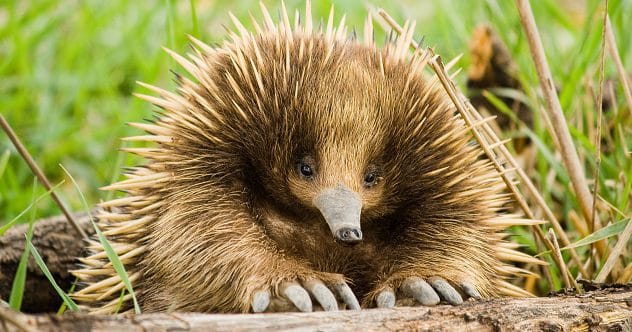Life in the wild is a constant battle, filled with stunning adaptations and ever-present dangers. We often hear about common survival tricks like camouflage or sharp claws. But some creatures have evolved truly mind-boggling solutions to problems that would seem insurmountable to us. Prepare to be amazed as we explore animals overcoming challenges in ways you’d never expect!
10 Woodpeckers: Dodging Brain Damage
Imagine repeatedly slamming your head against a solid surface up to 20 times per second, with forces reaching 15 mph. For us, that’s a recipe for severe concussions. Yet, woodpeckers do this daily to find food and build nests. How do they avoid constant brain injury?
Their secret lies in their unique anatomy. Woodpeckers have tiny, lightweight brains (around 2 grams) that absorb minimal impact. A dense, spongy skull acts as a natural shock absorber. Plus, they possess a special hyoid bone. This remarkable bone wraps around their skull, functioning like a safety harness for their brain. This design is so effective that engineers have studied it to create better helmets and neck protection for humans.
9 Naked Mole Rats: Surviving Suffocation
Naked mole rats are famous for their wrinkly, hairless bodies and their complex underground tunnel systems. Living deep underground, however, comes with a serious risk: oxygen levels can plummet due to overcrowding or poor ventilation. While a mouse might perish in 20 seconds without oxygen, these critters can survive nearly 20 minutes without breathing.
Amazingly, their brain cells don’t die from oxygen deprivation like other mammals. When oxygen is scarce, a naked mole rat’s body slows down, entering a vegetative-like state to conserve energy. Their metabolism switches gears, much like a plant’s. Instead of relying solely on glucose (which needs oxygen), they can process fructose for energy through an anaerobic pathway—a trick previously thought to be exclusive to plants.
8 Echidnas: Enduring Raging Bushfires
Echidnas, Australia’s spiky anteaters, are quite slow-moving. This might seem like a disadvantage on a continent prone to fierce bushfires. Instead of trying to outrun the flames—a race they’d likely lose—echidnas employ a brilliant survival tactic.
They dig themselves deep into the cool soil and enter a state of torpor. This state significantly lowers their body temperature and metabolic rate. While they’re safely snoozing underground, the fire might rage above, sometimes even melting the keratin spines on their back into blunt stubs. Since these spines have no nerves, the echidna feels no pain and the spines eventually regrow. Once the danger has passed, they emerge, sometimes days later, ready to forage again, completely unfazed.
7 Wood Frogs: Thriving While Frozen Solid
Winters in places like Alaska and Canada can see temperatures drop to a bone-chilling -62°C (-80°F). Most frogs survive by hibernating deep underwater, where temperatures stay above freezing. Wood frogs, however, have a far more extreme approach. They huddle under leaf litter on the forest floor, which offers minimal protection from subzero conditions.
These remarkable amphibians allow themselves to freeze solid. Their heart stops, and they stop breathing, appearing completely dead. The trick is that ice forms outside their organs and cells, but not inside. Their liver produces vast amounts of glucose, which acts like an antifreeze, flooding every cell and preventing lethal internal ice crystals from forming. Come spring, they thaw out and get a head start on life while other frogs are still warming up underwater.
6 Black Widow Spiders: Preventing Sibling Cannibalism
Black widow females are infamous for their post-mating dining habits, but how do their offspring fare? In many spider species, the first and largest spiderlings to hatch often eat their smaller siblings. This grim reality is avoided in black widow families.
The mother black widow exhibits incredible timing. She ensures all her eggs hatch at almost precisely the same moment. This means all the spiderlings emerge at the same size and stage of development. With no clear size or strength advantage, none of them are keen to start a fight they might not win. This synchronized hatching promotes peace among the brood, preventing widespread sibling cannibalism and ensuring more survive.
5 Meerkats: Conquering Sun Glare
For meerkats, vision is paramount. These desert dwellers are active only when the sun is shining brightly and won’t even emerge if it’s too cloudy. This reliance on daylight means they constantly scan the skies for aerial predators like eagles and hawks. Staring towards the sun for long periods would cause painful glare and temporary blindness for most animals.
Meerkats, however, have a built-in solution: dark patches of fur around their eyes. These patches function just like the eye black athletes use, significantly reducing the sun’s glare. This allows them to maintain a sharp lookout even in bright conditions. Their long, horizontal pupils also give them awide field of vision, so they can watch for danger without constantly turning their heads.
4 Kingsnakes: Hunting Venomous Snakes Fearlessly
Cottonmouths, rattlesnakes, and copperheads are some of North America’s most feared venomous snakes. A bite from any of these can be fatal. You’d assume any animal hunting them would need incredible speed and precision to avoid their fangs. The kingsnake, however, isn’t too bothered if it gets bitten.
Kingsnakes are naturally resistant to the venom of these dangerous snakes. They possess enzymes that neutralize the toxic chemicals before they can cause harm. Growing up to 1.8 meters (6 feet), these nonvenomous constrictors confidently prey on other snakes in their territory, earning their regal name by dominating even the most venomous neighbors.
3 Roosters: Crowing Loudly Without Going Deaf
A rooster’s crow is impressively loud, often exceeding 100 decibels—comparable to a chainsaw. Humans exposed to such noise levels without ear protection risk permanent hearing damage due to the death of inner ear hair cells. Yet, roosters crow heartily every morning without any apparent ill effects, a puzzle that intrigued scientists.
Research revealed that roosters have natural ear protection. When a rooster tilts its head back to crow, its ear canal becomes completely covered by a sound-dampening material, acting like built-in earplugs. Additionally, about half of their eardrum is covered by soft, sound-absorbing tissue. Unlike mammals, birds can also regenerate damaged cochlear hair cells, offering another layer of auditory defense.
2 Planarians: Regenerating From Tiny Pieces
Being sliced into multiple pieces usually means certain death. But for the planarian, a simple aquatic flatworm, it’s just an opportunity to multiply. These tiny creatures can be cut into numerous fragments, and astonishingly, each piece can regenerate into a complete new worm within about a week.
Their incredible regenerative ability comes from the fact that about 20% of their body is composed of pluripotent stem cells. These cells can develop into any type of tissue or cell the fragment needs to become a whole organism. Scientists have found that even a tiny piece, as small as 1/279th of the original planarian, can regrow into a full-sized body. This makes them invaluable for research into regeneration.
1 Lungfish: Surviving Years Out of Water
Most fish out of water are doomed. The lungfish, however, is an ancient marvel, dating back 400 million years, equipped with a sophisticated respiratory system that allows it to survive without water for extended periods, even years.
As their name suggests, lungfish possess lungs in addition to gills, enabling them to breathe air just like land animals. When the dry season arrives and ponds evaporate, other fish perish in the mud. But the lungfish has a plan. It burrows deep into the mud, headfirst, pushing mud out through its gills. Once at a suitable depth, it curls up, mouth near the surface to breathe, hidden from predators. It secretes mucus which hardens into a protective cocoon, leaving only its mouth exposed. In this state of hibernation, it can survive for up to four years, living off energy stored in its tail muscles, patiently waiting for the rains to return.
Nature’s Ingenuity on Full Display
The animal kingdom is full of surprises, and these ten creatures are a testament to the power of evolution. From woodpeckers with built-in helmets to lungfish that can live without water for years, these animals have developed incredible solutions to problems that would seem utterly devastating. Their unique adaptations not only ensure their survival but also offer us a glimpse into the remarkable creativity of nature.
Which of these amazing animal adaptations astonished you the most? Do you know of any others? Share your thoughts in the comments below!










